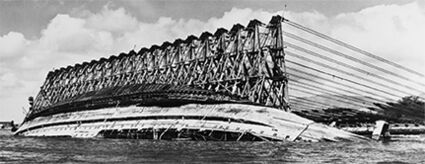COMMENTARY
The Day of Infamy
December 29, 2022

-Submitted photo
The gantries attached to the hull of the U.S.S. Oklahoma and high-tension cables were used to rotate the hull right-side-up in 1943.
My folks were children of the 1930s and were in their formative years in the early 1940s as World War II raged, so the news release caught my eye and my curiosity.
The Navy was announcing that Hoquiam native Machinist's Mate 2nd Class Lorentz Emanuel Hultgren, whose hometown is Tacoma, will be buried in the National Memorial Cemetery of the Pacific, or "Punchbowl," in Hawaii on January 9, 2023.
Hultgren was on BB 37, the U.S.S. Oklahoma, the morning of Sunday, December 7, 1941, when the Japanese attacked, hurtling the United States into the world war.
Huh?
The USS Oklahoma was moored in Battleship Row, beside the USS Maryland, and was among the first ships hit by Japanese aerial torpedoes when the attack commenced at 7:55 a.m.
"The U.S.S. Oklahoma began capsizing as the Japanese planes strafed the deck with machine gun fire," the Navy release states. "After being struck by six more torpedoes, the Oklahoma's port side was torn open and within 15 minutes of the first torpedo strike, she had rolled completely over, trapping those crewmembers not fortunate enough to escape within her hull.

"Men trapped inside started banging on the bulkhead trying to get the attention of passing small boats. On December 8 and 9, after cutting holes in the exposed bottom of the ship, 32 men were pulled out alive. Banging continued through Dec. 10, but nothing could be done. The sound was coming from below the water line and the helpless Sailors standing watch over the Oklahoma could only wait and listen until the banging stopped. In total, 429 U.S.S. Oklahoma Sailors lost their lives."
Sailors, soldiers and Marines transiting through Pearl Harbor to the South Pacific didn't need to be reminded to "Remember Pearl Harbor." The USS Oklahoma remained capsized until it was righted in 1943 and 429 Sailors' remains were recovered.
Only 35 were able to be identified, the other 388 unidentified Sailors and Marines were interred as "unknowns," disinterred in 1947 in an unsuccessful attempt to further identify them, and, in 1950, all unidentified remains were buried in 61 caskets in 45 graves in the "Punchbowl."
In April, 2015, the remains were exhumed for DNA analysis, comparing genetic markers with known family members. By December, 2017, 100 Sailors had been identified; on February 26, 2019, the 200th known Oklahoma sailor was identified, and on January 28, 2021, the 300th unknown, a member of the USMC detachment, was identified. On December 7, 2021, on the 80th anniversary of the attack, the final 33 sailors unidentified by DNA were reinterred at the National Cemetery of the Pacific.
Hultgren was one of those Sailors subsequently identified.
The USS Oklahoma remained capsized through most of the war as the Navy triaged ships with less damage, repairing and returning them to service, thereby leaving the Oklahoma and Utah to be the last ships to receive serious attention, the Navy indicated.
It took eight months to right the boat. Divers made 1,848 dives involving 10,279 man-hours under pressure.
"Air was pumped into interior chambers and improvised airlocks built into the ship, forcing 20,000 tons of water out of the ship through the torpedo holes. Four thousand, five hundred tons of soil were deposited in front of her bow to prevent sliding and two barges were posted on either end of the ship to control the ship's rising. Twenty-one derricks were attached to the upturned hull; each carried high-tensile steel cables that were connected to hydraulic winching machines ashore. The operation began on March 8, and was completed by June 16, 1943.
"Teams of naval specialists then entered the ship to remove any additional human remains.
"Cofferdams were then placed around the hull to allow basic repairs so the ship could be refloated. The Oklahoma was eventually floated using twenty 10,000 gallon-per-minute pumps during an 11-hour period on November 3, 1943.
"December 28, 1943: Oklahoma towed into dry dock, repaired enough to make her watertight. USS Oklahoma was decommissioned in September, 1944, and sold to Moore Drydock Co. of Oakland, Calif., for $46,127. In May, 1947, two tugs, Hercules and Monarch, began towing the Oklahoma to California.
"May 17, 1944: The tugs entered a storm more than 500 miles from Hawaii. Hercules put her searchlight on the former battleship, revealing that she had begun listing heavily. After radioing Pearl Harbor, both tugs were instructed to turn around and head back to port. Without warning, Hercules was pulled back past Monarch, which was being dragged backwards at 15 knots (17 mph). Oklahoma had begun to sink straight down, causing water to swamp the sterns of both tugs. To save themselves, the crews released her and let her sink. The Oklahoma's plunge to the bottom of the Pacific was recorded at 1:40 a.m., but her exact location is unknown.
"The ship's wheel and a section of her deck are now on display at the Oklahoma Historical Society Museum. The anchor is located in downtown Oklahoma City, Oklahoma. Inscribed on its base: "Eternal Vigilance is the Price of Liberty."
